Introduction
Waterleaf is a vegetable crop native to and grown in Africa, Asia, and Central and South America (USDA, NRCS 2020). This crop belongs to the purslane family, Portulaceae (Carolin 1987). Waterleaf (Talinum triangulare (Jacq.) Willd) is often used interchangeably with Talinum fruticosum (L.) Juss (Schippers 2000). Waterleaf is commonly known as Ceylon spinach, Surinam purslane, Philippine spinach, Grassé grand pourpier, Blatt-ginseng, Lustrosa-grande, Espinaca de Java, and Sweetheart (USDA, NPGS 2020). Waterleaf is a short life-span species and takes an average of only 30–45 days from planting to harvest (Iren et al. 2017). The edible leaves are soft, succulent, and highly nutritious (Figure 1). Waterleaf does not appear on the list of invasive plants species evaluated by the UF/IFAS Assessment (http://assessment.ifas.ufl.edu). This vegetable is available in some local grocery stores in Florida but is new to most people in Florida and its environs. This article will give an overview of this emerging vegetable in Florida. The intended audience is county Extension faculty, students, growers, and consumers.
The plants of this crop can adapt to varying climate conditions and low soil fertility (de Oliveira Amorim et al. 2014). Waterleaf production is economically attractive due to low cost for seeds, pesticides, and herbicides for producing the crop. Like other leafy vegetables, waterleaf can be grown in home gardens as well.
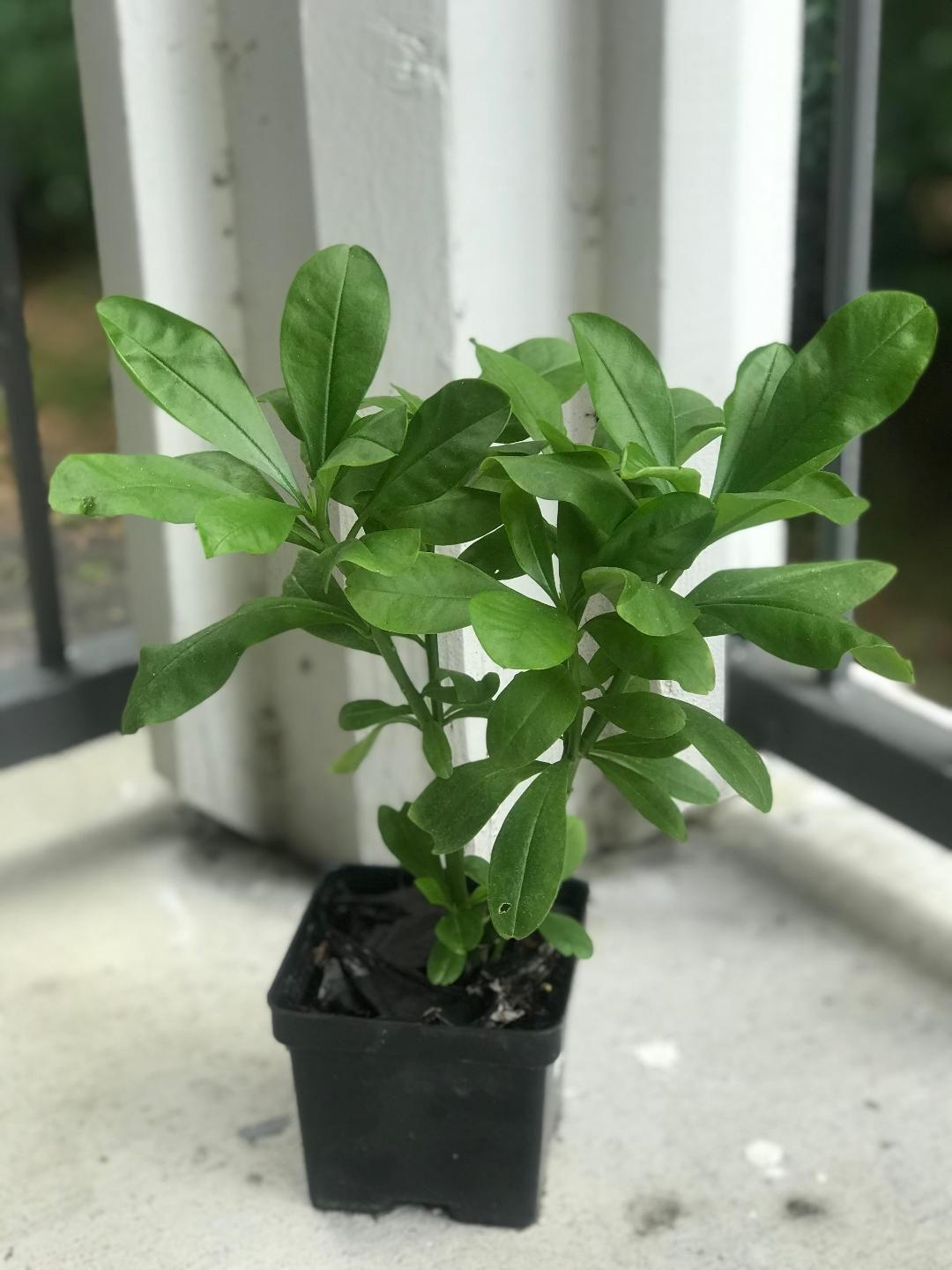
Credit: Christianah T. Oladoye, UF/IFAS
Characteristics
Waterleaf is an erect perennial herb species with swollen roots and obtuse-angular, hairless, and succulent stems, which can grow to 3–10 feet in height (Aja et al. 2010). Stem branches have two lateral and basal buds. The leaves are arranged spirally and more clustered at the top of the stem. The leaf blades are usually spoon-shaped, succulent, and occasionally indented at the apex (Figure 2). Its light-green stems are smooth and have an erect growth habit, and the cross-sections of mature stems have a cylindrical shape, tapered at each end (Nya and Eka 2015). Waterleaf has pink-colored flowers, which are bisexual and primarily self-pollinate with limited outcrossing. The inflorescences are triangular. Fruit ripening occurs about two weeks from flowering (Schippers 2000). The fruits are light-green, ellipsoid capsules, which are dehiscent with many seeds that are dark brown and break open (Nya and Eka 2015).
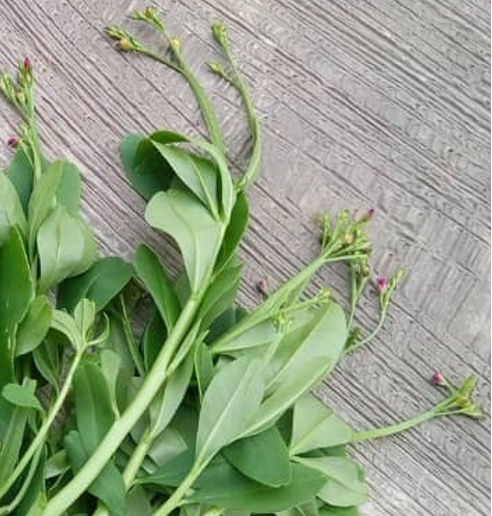
Credit: Dorcas Oladoye, Nigeria
Planting Methods
Waterleaf is usually propagated by seeds or vegetative cuttings. The 1000-seed weight is approximately 3.86 grains (0.25 g, 1 grain = 1/7000 pounds). Waterleaf seeds are easily acquired from the internet. A small pack of 400 seeds costs $10, and a large pack of 20,000 seeds, $12. The seeds often have low germination due to poor seed viability or seed dormancy and should be pregerminated. Seedlings can be transplanted to the field when 3 weeks old (Schippers 2004). As a result of the difficulty in establishing the crop using seeds, vegetative propagation is encouraged (Figure 3). Vegetative cuttings are taken from the mature stem in 5-to-8-inch segments and can be directly planted, without rooting, 2 inches deep on raised beds. Waterleaf is frequently intercropped with other vegetable crops; however, it can also be cultivated solely. The distance between rows should be 6 inches with between-plant spacing of 6 inches for low-fertility soil and 10 inches for fertile soil (Schippers 2004; Orluchukwu and Poripo 2014). Waterleaf seeds or cuttings can also be raised in small containers for transplant production before transferring into 1-to-5-gallon containers (Figure 1).
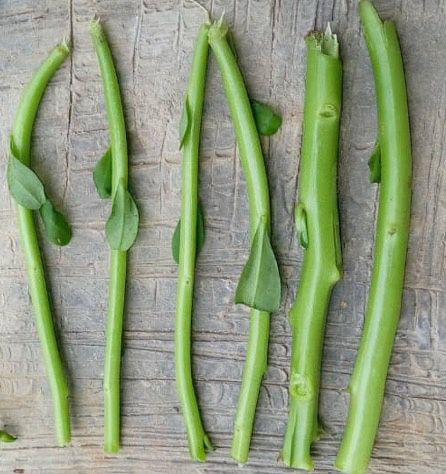
Credit: Dorcas Oladoye, Nigeria
Growing Season
Waterleaf is tolerant of a range of temperatures, moisture levels, and soil types. The crop grows well in warm climates with an average temperature of 68°F to 95°F; however, temperatures greater than 95°F adversely affect the yield. The appropriate soil pH for optimal growth and yield ranges from 6.1 to 7.5 (Iren et al. 2017). Waterleaf can withstand some flooding stress. Soil should be prepared based on the procedures used in the EDIS publication “Soil Preparation and Liming for Vegetable Gardens” (Stephens and Liu 2019). Waterleaf has seasonal requirements but can be grown throughout Florida in both spring and fall seasons. Waterleaf can be grown in northern and central Florida in spring, between March and July, and fall, between July and November. It can be grown in southern Florida from September through April.
Fertilizer Application
Currently, there is no UF/IFAS fertilizer recommendation available for waterleaf. Before the recommendations are established for Florida, growers can use the recommendations for collard greens production: optimum soil pH of 6.5; nitrogen rate of 175 lb/acre; and for each application of P2O5 and K2O, 120–150 lb/acre and100 lb/acre for low and medium nutrient levels of soil tests with Mehlich-3 extraction, respectively (Liu et al. 2021).
Pest and Diseases Control
Waterleaf is one of the few vegetables that is quite resistant to pests and diseases (Schippers 2000), although it is a host for root-knot nematode. However, for general routine management of pests in the vegetable field, biopesticide control can be used employing Azadirachta indica (neem extract).
Harvesting
Waterleaf grows vigorously in favorable conditions, and harvest can start 3 to 4 weeks after planting (Iren et al. 2017). The shoots can be harvested at an interval of 1 to 2 weeks for up to 2 months. The first 3 harvests provide the best commodity for marketing. After about four harvests, the plant yield declines. Waterleaf can be harvested either by hand or with a sharp knife (Figure 4). The best harvest method is to cut the stem approximately 1 inch above the ground. Waterleaf yield ranges from 10 to 55 tons per acre, depending upon soil fertility and growing conditions (Schippers 2004). Plant quality and freshness is best when harvested in the early morning when transpiration is minimal. The leafy produce of this crop is highly perishable and may start wilting a few hours after harvest. Harvested materials should be stored in plastic bags and refrigerated at a temperature of 61°F to 66°F to extend storage life (Ndukwu and Manuwa 2015).
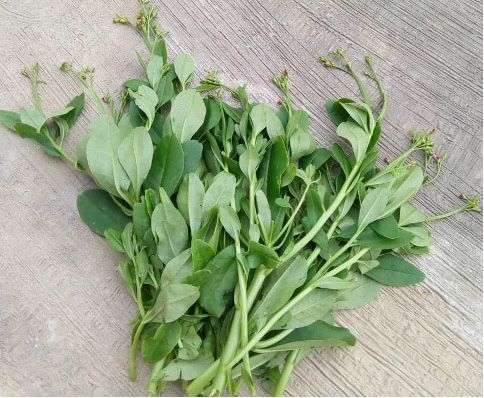
Credit: Dorcas O. Oladoye, Nigeria
Nutritional Benefits
Waterleaf is a good source of calcium, magnesium, potassium, vitamins, crude protein, alpha-tocopherols, beta-tocopherols, total lipids, and essential oils (Table 1). It is rich in minerals, amino acids, and ascorbic acid, which helps prevent scurvy. Waterleaf is rich in indigestible fiber, which aids in digestion. This plant is used as a natural pigment for food colorants (Swarna et al. 2013).
However, this vegetable should not be eaten raw in large quantities. It contains soluble oxalates, which may induce kidney stones if too much is consumed, and low amounts of hydrocyanic acid content (its cyanide content is lower than the dose range of 50–300 mg/kg of body weight) (Eleazu and Eleazu 2013). When cooked, oxalates are reduced by 50% and nitrates and nitrites (Willie and Eze 2016) reduce to negligible levels (Agunbiade et al. 2015). Waterleaf should not be incorporated into infant meals because of the antinutrients in it (Schippers 2000).
Health Benefits
Waterleaf has chemopreventive activity against colon and breast cancers due to its squalene content (Kristine et al. 2015). Waterleaf may also have the potential for regulating cardiovascular diseases such as stroke and obesity (Aja et al. 2010). Waterleaf can serve as a part of a weight-loss diet due to its high fiber content, and its leaves are used to treat several diseases, including measles (Oluwole et al. 2003). Also, leaf and root extracts are used for treating asthma, fresh cuts, scabies, anemia, and high blood pressure (hypertension) (Ogunlesi et al. 2010).
Other Uses
Waterleaf can also be used for ornamental purposes in urban and peri-urban spaces for urban greening and environmental protection (Satterthwaite et al. 2010). Additionally, waterleaf is used in bioremediation for accumulating heavy metals from soil exposed to anthropogenic activities (Anyalogbu et al. 2017). This crop also helps in minimizing the impact of soil erosion. Waterleaf can be used as forage for rabbits (Enete and Okon 2010). A component of the plant extract in drinking water boosts the immune response of broiler chicks against virulent Newcastle disease virus (Sanda 2015). Waterleaf extract serves as inhibitors of mild steel corrosion in acidic medium (Ajiwe and Ejike 2020).
How to Cook Waterleaf
Waterleaf should be washed thoroughly to remove debris and soil. It can be prepared by stir-frying, used as an ingredient in stew and soup with other seasonings like onions or chili peppers, or boiled as a vegetable (Figure 5). Waterleaf can be prepared with fish, ground melon, chicken, beef, or tofu to give different flavors. Waterleaf can be mixed into cookies to make veggie cookies. Leaves and young stems are often used as a softener in cooking fibrous vegetables or thickener in sauce in the southern region of Nigeria. The cooking of waterleaf should be on a low heat at 5–10 minutes to minimize denaturing. Waterleaf can be preserved by freeze-drying, solar drying, or oven drying.
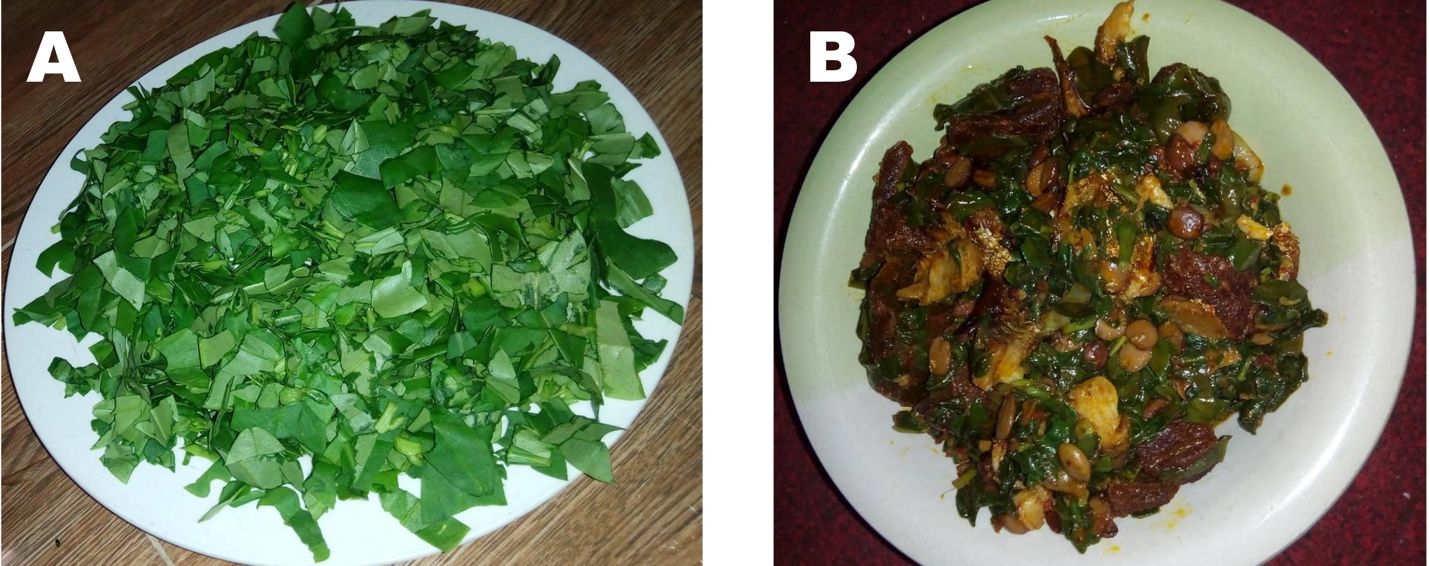
Credit: Racheal O. Oladoye, Nigeria
Summary
Limited supplies of waterleaf can be found in grocery stores in Florida. An emerging and expanding new crop, production may increase the income of vegetable growers. The climatic conditions in Florida are favorable for waterleaf production, giving an advantage compared to other growing areas. Its short life span and low production costs make it suitable in Florida’s soil conditions compared to other leafy vegetables. Waterleaf consumption can contribute to human health in several ways.
References and Further Reading
Agunbiade, S. O., M. O. Ojezele, and O. O. Alao. 2015. “Evaluation of the Nutritional, Phytochemical Compositions and Likely Medicinal Benefits of Vernomia amygdalina, Talinum triangulare and Ocimum basilicum Leafy-Vegetables.” Advances in Biological Research 9 (3): 151–155. https://doi.org/10.5829/idosi.abr.2015.9.3.93185. Retrieved February 15, 2023, from https://www.idosi.org/abr/9(3)15/4.pdf
Aja, P. M., A. N. C. Okaka, P. N. Onu, U. Ibiam, and A. J. Urako. 2010. “Phytochemical Composition of Talinum triangulare (Water Leaf) Leaves.” Pakistan Journal of Nutrition 9 (6): 527–530. https://doi.org/10.3923/pjn.2010.527.530
Ajiwe, V. I. E., and C. E. Ejike. 2020. “Talinum triangulare (Waterleaf) Methanol Leaf Extract as Corrosion Inhibitor on Mild Steel Surface in H2SO4.” Colloid and Surface Science 5 (1): 6–12. https://doi.org/10.11648/j.css.20200501.12
Anyalogbu, E. A. A., C. C. Anadi, P. C. Nwweje-Anyalowu, and M. C. Nnoli. 2017. “Use of Waterleaf (Talium triangulare) in Remediation of Soil Exposed to Heavy Metals: A Green Technology Approach.” World Journal of Pharmaceutical and Life Sciences 3 (9): 48–53.
Carolin, R. 1987. “A Review of the Family Portulacaceae.” Australian Journal of Botany 35 (4): 383–412. https://doi.org/10.1071/BT9870383
de Oliveira Amorim, A. P., A. R. de Carvalho Jr., N. P. Lopes, R. N. Castro, M. C. C. de Oliveira, and M. G. de Carvalho. 2014. “Chemical Compounds Isolated from Talinum triangulare.” Food Chemistry 160:204–208. https://doi.org/10.1016/j.foodchem.2014.01.114
Eleazu, C. O., and K. C. Eleazu. 2013. “Bioactive Constituents and In Vitro Antioxidant Capacity of Water Leaf (Talinum triangulare) as Affected by Domestic Cooking.” European Journal of Medicinal Plants 3 (4): 540–551. https://doi.org/10.9734/EJMP/2013/4577
Enete, A. A., and U. E. Okon. 2010. “Economics of Waterleaf (Talinum triangulare) Production in Akwa Ibom State, Nigeria.” Field Actions Science Reports 4:1–5. http://journals.org/factsreports/438
Iren, O. B., E. O. Ayito, P. O. Okon-inyang, and K. I. Ofem. 2017. “Soil Nutrient Status and Yield of Waterleaf (Talinum triangulare Jacq) as Influenced by Rates of Organomineral Fertilizer in a Rainforest Utisol, Nigeria.” International Journal of Applied Research 3 (5): 581–585.
Kristine, B., S. Chien-Chang, and R. Consolacion. 2015. “Chemical Constituents of Talinum triangulare.” Research Journal of Pharmaceutical, Biological and Chemical Sciences 6 (1): 167–171.
Liu, G. D., E. H. Simonne, K. T. Morgan, G. J. Hochmuth, S. Agehara, R. Mylavarapu, and P. B. Williams. 2021. “Chapter 2. Fertilizer Management for Vegetable Production in Florida.” EDIS 2021 (VPH). https://doi.org/10.32473/edis-cv296-2021
Ndukwu, M. C., and S. I. Manuwa. 2015. “Impact of Evaporative Cooling Preservation on the Shelf Life of Fruits and Vegetable in South Western Nigeria.” Res. Agr. Eng. 61 (3): 122–128. https://doi.org/10.17221/54/2013-RAE
Nya, E. J., and M. J. Eka. 2015. “Morphological Characterization and Hybridization of Talinum triangulare Land Races for Desirable Metric Characters in South Eastern Nigeria.” The International Journal of Science and Technoledge 3 (7): 192–197.
Ogunlesi, M., W. Okiei, L. Azeez, V. Obakachi, M. Osunsanmi, and G. Nkenchor. 2010. “Vitamin C Contents of Tropical Vegetables and Foods Determined by Voltammetric and Titrimetric Methods and Their Relevance to the Medicinal Uses of the Plants.” International Journal of Electrochemical Sciences 5:105–115.
Oluwole, F. S., A. O. Falade, and O. O. Ogundipe. 2003. “Anti-inflammatory Effect of Some Common Nigerian Vegetables.” Nig. J. Physiol. Sci. 18 (1): 35–38. https://doi.org/10.4314/njps.v18i1.32616
Orluchukwu, J. A., and C. Poripo. 2014. “Growth and Yield Response to Plant Density of Waterleaf (Talinum triangulare) in Rivers State, Nigeria.” Nigerian Agricultural Journal 45 (1): 31–36.
Sanda, M. E. 2015. “Effects of Waterleaf (Talinum triangulare) Extract on Performance and Immune Response of Broilers Vaccinated with Newcastle Disease Vaccine (LaSota).” International Journal of Food, Agriculture and Veterinary Sciences 5 (2): 60–63.
Satterthwaite, D., G. McGranahan, and C. Tacoli. 2010. “Urbanization and Its Implications for Food and Farming.” Philosophical Transactions of the Royal Society B 365 (1554): 2809–2820. https://doi.org/10.1098/rstb.2010.0136
Schippers, R. R. 2000. “African Indigenous Vegetables, an Overview of the Cultivated Species.” Chatham, UK: Natural Resources Institute/ACP EU Technical Center for Agricultural.
Schippers, R. R. 2004. “Alphabetical Treatment of Vegetables.” In Plant Resources of Tropical Africa 2—Vegetables, edited by G. J. H. Grubben, O. A. Denton, C.-M. Messiaen, R. R. Schippers, R. H. M. J. Lemmens, and L. P. A. Oyen, p. 668. Wageningen, Netherlands: PROTA Foundation.
Stephens, J., and G. D. Liu. 2019. “Soil Preparation and Liming for Vegetable Gardens.” EDIS 2013 (6). https://edis.ifas.ufl.edu/vh024
Swarna, J., T. S. Lokeswari, M. Smita, and R. Ravindhran. 2013. “Characterisation and Determination of In Vitro Antioxidant Potential of Betalains from Talinum triangulare (Jacq) Willd.” Food Chemistry 141 (4): 4382–90. https://doi.org/10.1016/j.foodchem.2013.06.108
USDA, Agricultural Research Service, National Plant Germplasm System. 2022. “Talinum fruticosum (L.) Juss.” Germplasm Resources Information Network (GRIN Taxonomy). National Germplasm Resources Laboratory, Beltsville, Maryland. https://npgsweb.ars-grin.gov/gringlobal/taxonomydetail.aspx?id=402262
USDA Natural Resources Conservation Service. n.d. “Talinum triangulare (Jacq.) Willd. Ceylon Spinach.” https://plants.sc.egov.usda.gov/core/profile?symbol=TATR2
Willie, E. S., and C. C. Eze. 2016. “Effect of Removal of Inflorescence on Fresh Vegetable Yield in Waterleaf [Talinum triangulare (Jacq.) Willd].” Journal of Agriculture and Veterinary Science (IOSR-JAVS) 9 (7): 1–4. https://doi.org/10.9790/2380-0907010104. Retrieved February 15, 2023, from https://iosrjournals.org/iosr-javs/papers/vol9-issue7/Version-1/A0907010104.pdf
Table 1. Nutrient value of waterleaf (Eleazu and Eleazu 2013).